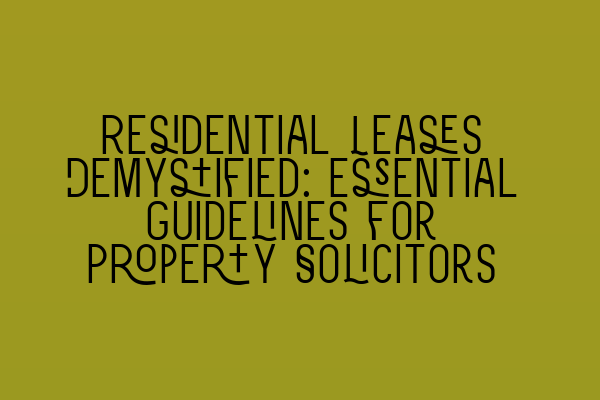Residential Leases Demystified: Essential Guidelines for Property Solicitors
Introduction
Residential leases can be a complex area of property law, requiring expertise and careful attention to detail. As a property solicitor, it’s essential to have a thorough understanding of the intricacies involved in residential leases to provide your clients with the best advice and representation. In this blog post, we will demystify residential leases, providing you with essential guidelines to navigate this area of property law with confidence and proficiency.
1. Understanding Residential Leases
A residential lease is a legally binding agreement between a landlord and a tenant for the rental of a residential property. It sets out the rights, responsibilities, and obligations of both parties during the tenancy period. As a property solicitor, it’s crucial to ensure that the lease agreement is clear, comprehensive, and tailored to meet the specific needs of your client.
2. Key Elements of a Residential Lease
a. Duration: The lease should clearly state the duration of the tenancy, including start and end dates, as well as any provisions for renewal or termination.
b. Rent and Payment Terms: The lease should outline the amount of rent, frequency of payment, and acceptable payment methods. It should also specify any penalties for late payment or bounced checks.
c. Maintenance and Repairs: The responsibilities for maintenance and repairs should be clearly defined, ensuring that both the landlord and tenant understand their obligations. Include provisions for routine maintenance as well as handling repairs arising from damage or wear and tear.
d. Use and Restrictions: Specify the permitted use of the property, including any restrictions on subletting, pets, or alterations. This section should also cover any specific regulations or guidelines that the tenant must adhere to.
e. Deposits and Security: Address the issue of security deposits, including the amount, conditions for refund or deduction, and compliance with relevant legislation.
3. Compliance with Regulations and Acts
As a property solicitor, you must ensure that a residential lease complies with all relevant regulations and acts. These may include:
a. The Landlord and Tenant Act 1985: This Act sets out various rights and obligations of landlords and tenants, including repair responsibilities, rent increases, and access to the property.
b. The Housing Act 2004: This Act covers various aspects of housing standards, including safety regulations and requirements for energy efficiency.
c. The Tenancy Deposit Scheme: Make sure that any deposit held by the landlord is protected in a government-approved scheme, as required by law.
4. Drafting and Reviewing Lease Agreements
To provide the best service to your clients, it’s essential to draft and review residential lease agreements meticulously. Pay careful attention to:
a. Precision and Clarity: Use clear and concise language to ensure that all terms and conditions are easily understood by both parties.
b. Tailoring to Client’s Needs: Customize the lease to reflect the specific requirements and circumstances of your client, including any additional clauses or provisions necessary to protect their interests.
c. Legal Compliance: Ensure that the lease complies with all relevant regulations and acts, as mentioned earlier.
d. Thoroughness: Leave no room for ambiguity or uncertainty by addressing all potential scenarios and potential disputes that may arise during the tenancy.
5. Ongoing Duties and Responsibilities
Once a residential lease is in effect, both the landlord and tenant have ongoing duties and responsibilities that should be clearly understood. These may include:
a. Inspection and Inventory: Conduct thorough inspections and prepare detailed inventories at the start and end of the tenancy to accurately assess any damages or discrepancies.
b. Lease Renewal or Termination: Guide your clients through the process of lease renewal or termination, ensuring compliance with legal requirements and mitigating potential disputes.
c. Dispute Resolution: If disputes arise during the tenancy, assist your clients in resolving them amicably and within the bounds of the law. Familiarize yourself with alternative dispute resolution methods such as mediation or arbitration.
Conclusion
Residential leases are a critical aspect of property law, and as a property solicitor, it’s essential to have a deep understanding of their intricacies. By following the guidelines outlined in this blog post, you can effectively navigate the world of residential leases, providing your clients with the expertise and advice they need.
Remember, staying up to date with relevant legislation and regulations is crucial for success in property law. If you’re preparing for the SQE exams or seeking further guidance, consider checking out our related articles:
– SQE 1 Practice Exam Questions: Get hands-on practice with our comprehensive set of SQE 1 practice exam questions.
– SQE 1 Practice Mocks FLK1 FLK2: Explore our SQE 1 practice mocks to assess your knowledge and improve your performance.
– SQE 2 Preparation Courses: Prepare yourself for the SQE 2 exams with our specialized preparation courses.
– SQE 1 Preparation Courses: Enhance your knowledge and skills with our SQE 1 preparation courses.
– SRA SQE Exam Dates: Stay informed about the latest SRA SQE exam dates to plan your study schedule effectively.
At SQE Property Law & Land Law, we are committed to assisting you in achieving success in your property law career. Contact us today to learn more about our services and how we can support your professional growth.
